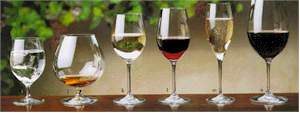
What goes where on the table and which glasses go with what drinks?
Real easy to remember, the etiquette experts tell us. The general rule with utensils is to start from the outside of your place setting, and work your way toward the service plate (the main meal plate): soup spoon first, then fish knife and fork, then service knife and fork.
When to start eating:
Despite what mother told you, culinary experts say you do not always have to wait for everyone to begin – start eating hot food when it is served. For cold foods or buffets, wait for the host to announce dinner and wait until the head guest starts dishing.
The correct table settings

|
A |
B |
C |
D |
E |
|
Serviette (napkin) |
Service plate |
Soup bowl on plate |
Bread & butter plate |
Water glass |
|
F |
G |
H |
I |
J |
|
White wine |
Red wine |
Fish fork |
Dinner Fork |
Salad fork |
|
K |
L |
M |
N |
|
|
Service knife |
Fish knife |
Soup spoon |
Dessert spoon and cake fork |
|
|
Note that it often is recommended that the salad fork (J) is placed to the left of the dinner fork (I). However, in this formal setting the dinner fork is placed to be used before the salad fork because it is suggested that the guest awaits the main meal before helping him/herself to the salad. |
||||
Foods you can get by hand:
1. Bread: Break slices of bread, rolls and muffins in half or into small pieces by hand before buttering.
2. Bacon: If there’s fat on it, eat it with a knife and fork. If it is crisp, crumble it with a fork and eat with your fingers.
3. Finger meals: Follow the cue of your host. If finger meals are offered on a platter, place them on your plate before putting them into your mouth.
4. Foods meant to be eaten by hand: Corn on the cob, spareribs, lobster, clams and oysters on the half shell, chicken wings and bones (in informal situations), sandwiches, certain fruits, olives, celery, dry cakes and cookies.
Removing inedible items from your mouth:
1. Olive pits: Drop delicately into your palm before putting them onto your plate.
2. Chicken bone: Use your fork to return it to the plate.
3. Fish bones: Remove with your fingers.
4. Bigger pieces: Bigger bones or food you don’t appreciate you should surreptitiously spit into your serviette (napkin), so that you can keep it out of sight.
Which glasses go with what drinks?
Wine connoisseurs agree that each type of wine needs a particular type of glass to bring out the distinctive bouquet. Using a narrow glass for a rich Burgundy, for example, won’t allow enough room to swirl it around in, and it’s the swirl that brings out its bouquet. The glass also needs to taper properly toward the top so that it captures the bouquet yet allows for sipping. In general, the stem of a glass should be long enough to keep hands from touching the bowl, which can affect the wine’s temperature, and therefor its bouquet.

Water | Brandy | White wine | Pinor Noir/Burgundy | Sparkling wine | Red wine
a. Water: Full body glass with short stem. Hold the glass by the stem to preserve its chill.
b. Brandy: Brandy snifter. Roll the snifter between both hands and then cup it in one hand – warming the glass brings out the bouquet in brandy.
c. White wine: Slightly smaller glass with wider bowl to capture the bouquet. Hold the glass by the stem to preserve its chill.
d. Burgundy Reds and Pinot Noirs: A wide bowl to bring out their complexity. The glass is slightly taller than the white wine glass.
e. Champagne: A narrow fluted glass, which reduces the wine’s surface area and keep the bubbles from dissipating.
f. Red wine: The bigger of the wine glasses. Hold the glass at the bottom of the bowl where it meets the stem.
Bon appetit!
Now that you have the correct table setting and the proper wine glasses, see which wines go best with what food, and then make sure you have the right person to share it with!
Did you know?
Wine is sold in tinted bottles
because wine spoils when exposed to light. And the indentation at the bottom of
the bottle strengthens the structure of the bottle but also is there to trap
the sediments.